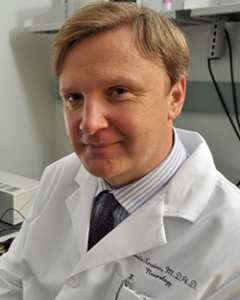
Northwestern Medicine scientists have discovered a link between a previously unknown mitochondrial process and Charcot-Marie-Tooth disease Type 2, a degenerative disease that can cause weakness and muscle atrophy in peripheral muscles, including those in the hands and feet.
A group of investigators led by Dimitri Krainc, MD, PhD, chair of the Ken and Ruth Davee Department of Neurology, uncovered how inter-mitochondrial contacts regulate mitochondrial movement, and found that many mutations that increase risk for Charcot-Marie-Tooth disease Type 2 (CMT2) had negative effects on this process. Their findings were published in the journal Developmental Cell and were an extension of Krainc’s recent discovery of direct contacts between mitochondria and lysosomes, previously published in Nature.
Mitochondria, the power-generating structures inside every cell, continuously combine to form complex and fluid networks to increase energy production or protect cells against stress. Previous studies have demonstrated these networks can dissolve just as soon as they’re assembled, processes called fission and fusion.
However, Krainc’s group discovered a third event, called inter-mitochondrial contact. During this process, mitochondria transiently tether with each other but do not fuse, playing a key role in regulating mitochondrial dynamics.
“It’s been relatively unstudied since it involves live-cell tracking of individual mitochondria at high resolution over time to confirm that inter-mitochondrial contact tethering and untethering events are distinct from fission or fusion events,” said Krainc, who is also the Aaron Montgomery Ward Professor, director of the Center for Neurogenetics and a professor of Neurological Surgery and of Physiology.
In the current study, Northwestern scientists used electron microscopy and live-cell super-resolution imaging to observe that up to 30 percent of mitochondria were in stable inter-mitochondrial contact at any time, and confirmed those contacts were an entirely separate event from the fusion and fission activity previously described: during tethering, the two mitochondria never combined into one organelle.
Investigating further, they also determined that mitochondria tethered to one another had reduced motility, and other organelles, including the endoplasmic reticulum and the lysosomes, were involved in the majority of observed untethering events.
“It was surprising to find the endoplasmic reticulum at sites of mitochondrial untethering, since it was already previously shown to be at fission sites, and more recently also at fusion sites,” Krainc said. “In addition, as our work suggests that lysosomes are able to regulate inter-mitochondrial contact untethering, disease involving mutations in lysosomal proteins which regulate lysosomal dynamics, motility and function may also contribute to restricted mitochondrial motility.”
This has relevance for CMT2, whose best-known risk mutations are in a gene called MFN2, which codes for a protein that helps build mitochondria. MFN2 mutations are known to cause mitochondrial dysfunction, but the specific mechanisms were not well understood.
Krainc’s group found that MFN2 mutations significantly prolong the duration of inter-mitochondrial contact and make it more difficult for joined mitochondria to untether, decreasing mitochondrial motility. In addition, other CMT2 risk genes including Rab7 and TRPV4 were also found to negatively impact mitochondrial motility through lysosomes or calcium misregulation, respectively.
All of these mutations pointing to one convergent pathway — reduced mitochondrial motility — makes this an interesting topic of future study, and potential therapeutic target for various disorders involving mitochondrial dysfunction, including Parkinson’s disease, according to Krainc.
Yvette Wong, PhD, a postdoctoral fellow in the Krainc laboratory, and Wesley Peng, student in the Medical Scientist Training Program, were co-lead authors of the study.
This work was supported by National Institutes of Health National Institute of Neurological Disorders and Stroke (NINDS) grants T32 NS041234, F32 NS101778, K99 NS109252 and R01 NS076054.






